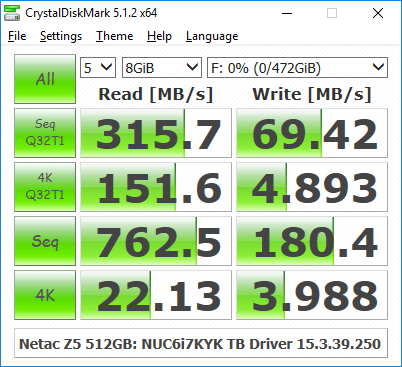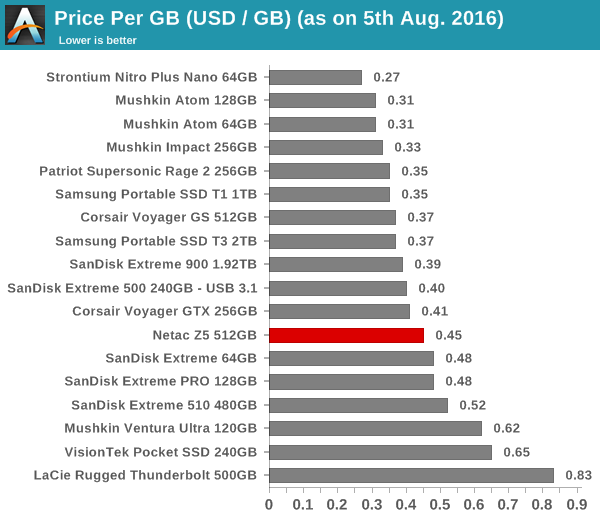Netac Z5 USB 3.1 Gen 2 Portable SSD Review
by Ganesh T S on August 9, 2016 8:00 AM ESTMiscellaneous Aspects
One of the major pain points associated with USB 3.1 Gen 2 SSDs (such as the SanDisk Extreme 900 and the Netac Z5 being evaluated today) is performance consistency across different host systems. There are two popular USB 3.1 Gen 2 bridge chips used by systems and boards currently in the market - the ASMedia ASM1142 and the Intel Alpine Ridge. The driver scenarios for both are quite tricky, depending on the vendor of the board / card / system. ASMedia's custom drivers for ASM1142 are no longer needed, given that Windows 10 bundles a Microsoft USB 3.1 xHCI driver. In the case of Alpine Ridge, even though the Microsoft xHCI drivers are utilized, the Thunderbolt driver version also plays a major role in the performance.
We evaluated the performance of the Netac Z5 across a host of different systems using multiple driver versions.

As one can see from the CrystalDiskMark numbers, the performance is heavily dependent on the drivers being used. In multiple cases, we found that writes wouldn't go above 100 MBps. To confound matters further, the ASMedia ASM1142-equipped systems sometimes performed worse with newer driver versions. It is always good to ensure that the proper drivers (as suggested by the vendor) are utilized when it comes to getting the maximum performance out of USB 3.1 Gen 2 devices such as the Netac Z5.
Pricing and Availability
The Netac Z5 is currently available in the retail market only in China. While trying to look up the pricing information, we chanced upon a Chinese e-tailer listing for the unit at ¥1509.00 (approximately USD 228).

The device most similar to the Netac Z5 that we have evaluated before is the SanDisk Extreme 900 1.92TB Portable SSD. On a $/GB basis, the Netac Z5 is priced higher compared to that. However, when considering similar capacities, the Extreme 900 480GB retails for $300, while the Netac Z5 512GB is priced at $228. This is a considerable price difference in favor of the Netac Z5. The prospect of lowered prices for USB 3.1 Gen 2 client devices is sure to drive mass adoption of the technology.
Final Words
The number of client devices that can take advantage of the full capabilities of USB 3.1 Gen 2 are few in number. Coming to the business end of the review, we are pleased to have evaluated one of those devices and be able to compare its performance to the SanDisk Extreme 900 that we reviewed earlier. The Z5 is a bit more compact compared to the SanDisk Extreme 900. The industrial design is also much more pleasing. However, in terms of power consumption (for idle and sustained loading conditions), the SanDisk Extreme 900 1.92TB version seems to fare better compared to the Netac Z5 512GB that we have reviewed today. The drivers in the host system also play a major role in the user-experience, but, Netac doesn't have control over that aspect.
Our concerns about the Netac Z5 are the typical ones we have for external SSDs - the absence of TRIM support over the ASMedia ASM1352R bridge chip, and a guarantee on the type of flash (MLC or TLC) that would be used across all the production units. Both of these have an effect on the long-term performance consistency of the product. External SSD vendors do not provide any workload ratings, and we can't fault Netac for not doing it either. That said, Netac does provide a 3-year warranty for the Z5. Our main suggestions for Netac would be to implement TRIM support and guarantee MLC flash (or, at the least, be upfront about what will be used in the units sold to consumers).
Usual concerns aside, the Netac Z5 is amongst the top performers when it comes to bus-powered direct-attached storage devices. Currently, putting two SATA SSDs in RAID-0 seems to be the most cost-effective way of getting a USB 3.1 Gen 2 storage device to the market. Netac has adopted the same strategy with the Z5. It has also managed to heavily undercut the price of the only other similar device in the market (the 480GB SanDisk Extreme 900). The Netac Z5 is a welcome addition to the family of USB 3.1 Gen 2 devices in the market, and we look forward to Netac adopting a wider distribution strategy for the product.











22 Comments
View All Comments
BrokenCrayons - Wednesday, August 10, 2016 - link
The skin temp of the Netac case was 46C. By the time heat reaches the exterior and is measured by an IR camera, it's dispersed from the sources that are creating it. This implies the internal temps experienced by the flash storage inside is higher. The good news is the Netac isn't throttling due to temperature as is made clear by the review. The temps measured were under atypically high demand too so day-to-day file copies wouldn't likely create that situation. However, since Ganesh has pointed out the company is aware of the thermal performance as a shortcoming, I think being dismissive of thermal concerns might be a mistake.Samus - Wednesday, August 10, 2016 - link
It's true using thermal pads to mate the controllers to the chassis will improve thermals, but if the drive isn't throttling, it is within design specifications, which means according to the manufacture reliability wont be sacrificed. So Netac concerning themselves with the thermals is superficial, and anything they do to improve them is a solution looking for a problem.I don't like my gadgets hot anymore than the next guy, but sometimes that's just how they are designed.
LordConrad - Tuesday, August 9, 2016 - link
"ASMedia's custom drivers for ASM1142 are no longer needed, given that Windows 10 bundles a Microsoft USB 3.1 xHCI driver."You should not assume that everyone is using Windows 10.
Samus - Tuesday, August 9, 2016 - link
Why aren't you using Windows 10? It was free for a whole year. Free!KingofL337 - Tuesday, August 9, 2016 - link
Would you really be willing to trust your data to some fly by night company? I can understand it's fast bust still.ganeshts - Tuesday, August 9, 2016 - link
I would hardly call Netac a 'fly by night' company given their background.Btw, if we even have a little bit of inkling / doubt that some vendor is a 'fly by night' operation, we would definitely NOT be reviewing their wares.
KingofL337 - Wednesday, August 10, 2016 - link
Maybe, 'fly by night' if the wrong wording how about 'unproven'.it looks like they took a reference design for the SM2246EN and slapped or will slap a set of the cheapest mSATA drives to the board. They aren't using their flash or Dram. They aren't available in the US except Amazon and they sell mostly cheap USB drives, uSD cards and a few HDDs with almost no reviews. Googling them basically shows their page, Amazon and this review.
These comments sure makes me feel warm inside.
Never been reviewed before or almost anyone else.
Prior to going into the specifics of the Netac Z5, a few words about Netac are in order, as none of their products have been reviewed by us before.
Not their own Flash, Dram or Controller
They use the Silicon Motion SM2246EN controller with Nanya DRAM and Micron NAND flash. Based on the package markings, it appears that the mSATA SSDs are using Micron MLC flash.
No Trim on a SSD, so this things is going to slow to a crawl.
TRIM support is shown in the information view, but, it is not possible to activate it behind the bridge chip.
No attempt at a thermal solution
In terms of actual thermal design, we were quite surprised to find that neither the SSD controllers nor the flash packages had any sort of thermal pad to aid in transferring the generated heat to the metal body.
Also these Chinese companies are adding no R&D effort slapping together or borrowing the design of these drives and marking them down a little and selling them. We put our data on them and they fail and so does all our data. We would never by a spinning disc made by a company like this.
ganeshts - Wednesday, August 10, 2016 - link
Other than Samsung, SanDisk and Micron / Crucial - who makes their own flash, DRAM or controller?So, if a company well-established in the Chinese market wants to get a presence / enter into the US market, does one immediately dismiss them because they haven't been reviewed by anyone in the US / EU press circles?
Btw, many of the flash devices that people buy in the US / EU are just the OEM designs developed by companies like Netac so that 'well-known' companies can just slap their labels on it and distribute with minimal QA work. That is how OEM designing works in the current day.
FWIW, the company is targeting distributors in the US market (not end buyers directly) with the Z5. So, someone who wants to distribute / slap their label on the Z5 can make Netac put in an improved thermal solution and/or improve firmware aspects before placing the bulk order.
name99 - Tuesday, August 9, 2016 - link
8W draw and no power brick? AND A USB-C to A cable. So they EXPECT you to run this on USB3 where the max guaranteed power supply is 4.5W?At the very least AnandTech should have run all tests under that scenario to see what happens. Does the box gratefully degrade, or does it just randomly disconnect when the power draw goes too high?
ganeshts - Tuesday, August 9, 2016 - link
We have been through this discussion on the USB 3.1 Gen 2 SanDisk Extreme 900 review also,At the outset - the usecase for this device is specifically with USB 3.1 Gen 2 ports.
Second, with USB 2.0 or USB 3.0 ports - it works without disconnects but performance is very limited, not crossing 400 MBps even in artificial workloads. I don't have a setup to measure power consumption with non-Type-C / USB 3.0 / USB 2.0 ports. So, I can't provide power numbers for those cases.